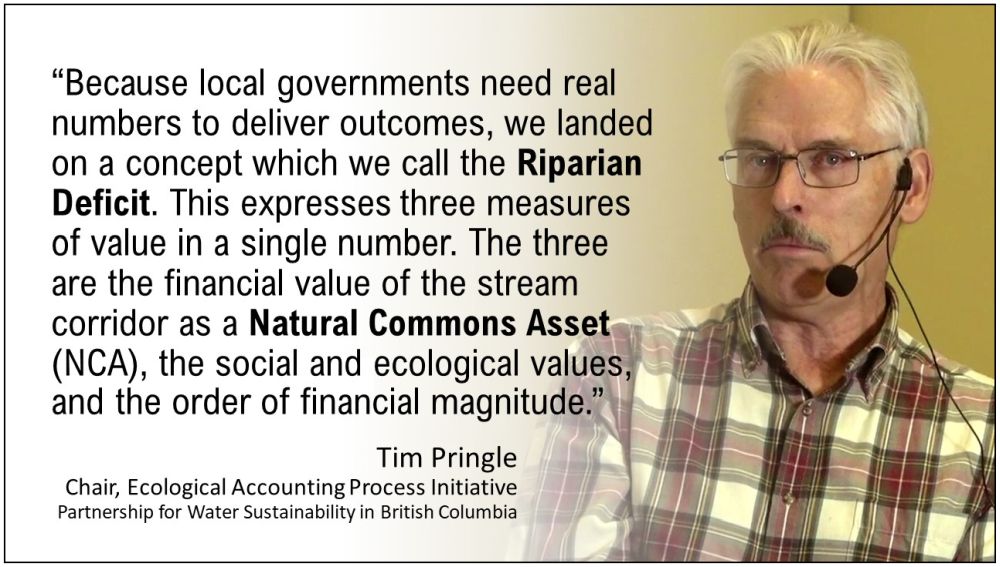DOWNLOAD BEYOND THE GUIDEBOOK 2022: “Because local governments need real numbers to deliver outcomes, we landed on a concept which we call the Riparian Deficit. This is a measure of land use intrusion into the streamside protection zone,” stated Tim Pringle, Chair of the Ecological Accounting Process (released June 2022)
Note to Reader:
In 2016, the Partnership for Water Sustainability in British Columbia embarked upon a 6-year program of applied research to evolve EAP, the Ecological Accounting Process, through a 3-stage building blocks process of testing, refining, and mainstreaming the methodology and metrics for financial valuation of stream systems. The program involved 9 case studies and 13 local governments and yielded 19 “big ideas” or foundational concepts.
In the edition of Waterbucket eNews published on June 14, 2022, the Partnership announced release of its Synthesis Report on the Ecological Accounting Process, a BC Strategy for Community Investment in Stream Systems. This is the 4th in the Beyond the Guidebook Series.

How much should communities invest in protection of stream systems?
“Know your history. Understand the context. These are key thoughts, and they provide perspective for the story of EAP, the Ecological Accounting Process, as told in the Synthesis Report. EAP comprises five cascading concepts (image below),” wrote Kim Stephens, Executive Director of the Partnership for Water Sustainability, in the preface to Beyond the Guidebook 2022: EAP, a BC Strategy for Community Investment in Stream Systems.
Beyond the Guidebook Series
Stormwater Planning: A Guidebook for British Columbia, released in 2002, is the foundation document for the Beyond the Guidebook Series of guidance documents. The titles themselves tell a story about the partnership journey in building on the Guidebook through case studies that showcase and celebrate good work, and advance implementation of science-informed approaches. The four documents in the series are:
Context for Rainwater Management and Green Infrastructure in British Columbia (2007)
Implementing a New Culture for Urban Watershed Protection and Restoration in British Columbia (2010)
Moving Towards “Sustainable Watershed Systems, through Asset Management (2015)
Ecological Accounting Process, A B.C. Strategy for Community Investment in Stream Systems (2022)

Building Blocks Process
“The EAP story is about a journey, one that began circa 1990 for pioneers working on parallel stream protection and restoration initiatives in British Columbia and Washington State. Three decades later, these parallel tracks have converged in the form of EAP. It has been a building blocks process requiring commitment, patience, and perseverance by many,” continued Kim Stephens.
“EAP provides local governments with the philosophy, methodology and metrics they need to make the financial case for stream systems. Maintenance and management (M&M) of stream systems can now be integrated into a Local Government Finance Strategy for sustainable infrastructure funding.”

The Riparian Deficit
“We can draw a direct line between EAP and the Fish Protection Act, passed in 1997 and re-named the Riparian Areas Protection Regulation Act in 2016. Circa 1990, Tim Pringle framed the challenge in terms that are still applicable:
“If we know how to do a much better job of protecting ecological features in our communities and on our landscape, then why aren’t we doing a better job? Why are streams still being degraded? Why do we still see practices that are embedded in land use policy and regulation that are 50 years old in some cases? How do we change that?”
“The philosophy that ‘use and conservation of land are equal values’ launched Tim Pringle on a career trajectory that has culminated with his breakthrough accomplishment in leading the EAP initiative. This 6-year program of applied research to test, refine and mainstream EAP provides local government with a path forward to address the Riparian Deficit.”
“The Riparian Deficit is the environmental equivalent of the Infrastructure Funding Gap. It puts the environmental perspective on an equal footing with the engineering and accounting perspectives. This is game-changing.”
“The Partnership mission is to develop tools and resources to help communities reconnect hydrology and stream ecology, by design. This includes a science-informed road map for restoring stream system integrity. Now it is up to communities to operationalize policy objectives spelled out in Living Water Smart, British Columbia’s Water Plan,” concluded Kim Stephens.

EAP, a BC Strategy for Community Investment in Stream Systems
“EAP uses real numbers. The methodology and metrics allow local governments to make a convincing financial case for annual investment in stream systems. The next step for them is to integrate budget line items for stream maintenance and management (M&M) into their Asset Management Strategies,” explains Tim Pringle, EAP Chair.
“It is amazing that we have been able to produce a methodology that defines what a stream is, can find the value of the stream using impartial BC Assessment data, and add to that a riparian assessment that looks at the 30m zone and a further 200m upland area to evaluate the water balance condition and what is happening to water pathways.”

“Now that we have landed on the Riparian Deficit concept, we are able to reflect on the two issues which provided context for the journey: first, engineering measures are insufficient for stream and riparian protection; and secondly, the link to municipal asset management has not been clear.”
“To reach the destination, we had to address and show how to overcome four challenges: one, a lack of measurable metrics; two, confusion over what is an asset versus a service; three, ignorance about how to quantify the financial value of natural assets with real numbers; and four, numerous one-off projects that fail to build improved asset management practice.”
To Learn More:
Download a copy of Ecological Accounting Process, A B.C. Strategy for Community Investment in Stream Systems (2022) – the Synthesis Report is a distillation of over 1000 pages of case study documentation into a storyline that is conversational and written for a continuum of audiences that includes land use practitioners, asset managers, stream stewards, and local government decision-makers.

DOWNLOAD A COPY OF https://waterbucket.ca/gi/wp-content/uploads/sites/4/2022/06/EAP-Synthesis-Report-Beyond-the-Guidebook-2022_Jun-2022.pdf

